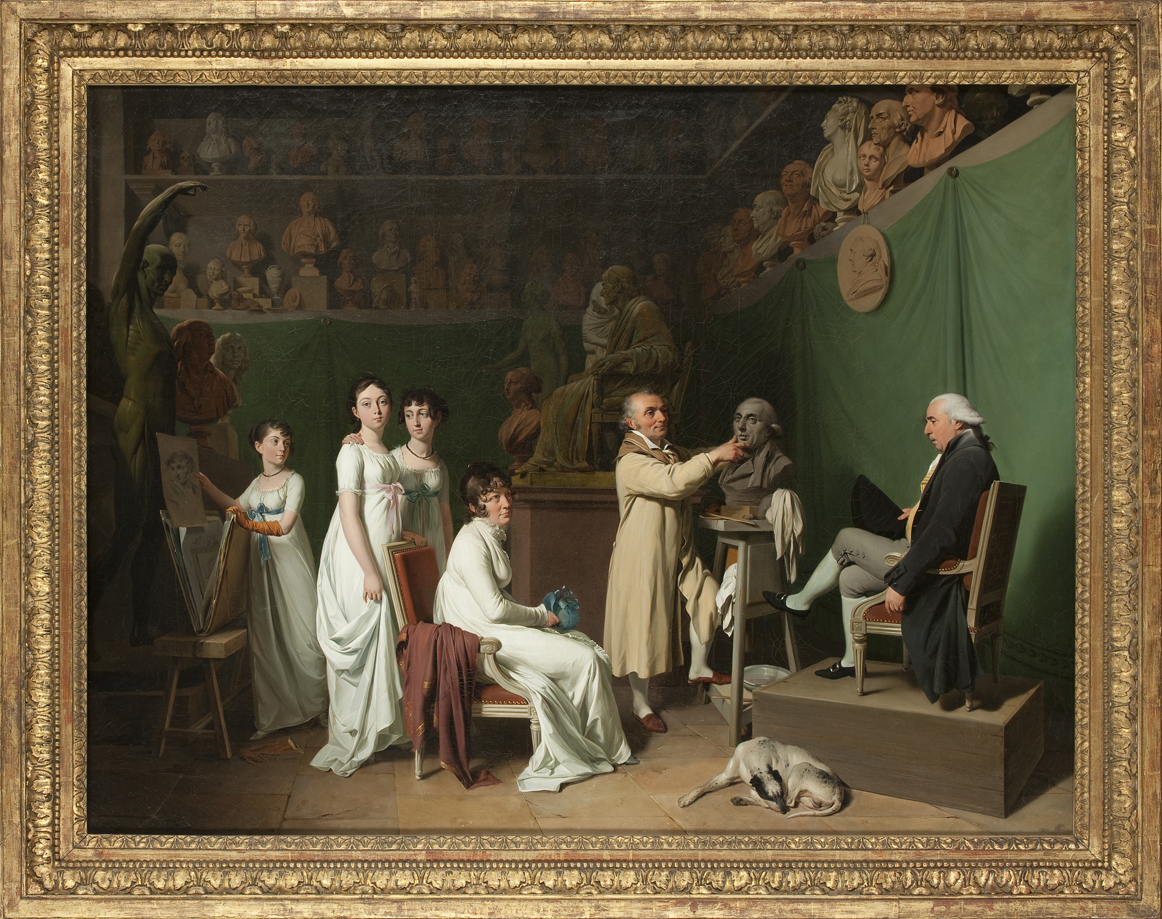Sculptures and paintings
Houdon’s Studio

Paris, circa 1804
_, oil on canvas
EMILE PEYRE bequest, 1905
Louis-Léopold Boilly was awarded a gold medal when he showed this picture at the 1804 Salon. It takes us into the privacy of one of the greatest sculptors of the 18th century, Jean-Antoine Houdon (1741-1828). The artist is shown here aged around sixty, at the height of his fame. He had sculpted an impressive gallery of celebrities of the Ancien Régime and the Revolution and was one of the artists nominated as members of the Institut de France when it was created in 1795. This picture has three distinct subjects: the depiction of an artist’s studio, the portrayal of a sculptor at work and a portrait of a family. The studio is the one in which Houdon worked on the ground floor of the Palais des Beaux-Arts, formerly the Collège des Quatre-Nations and now the Institut de France’s seat. In the middle of the picture, Houdon, surrounded by his works (most of which are identifiable), is finishing modelling his bust of the mathematician Laplace (1749-1827), on display next to this picture. His wife is seated in the foreground with their three daughters, Sabine, Anne-Ange and Claudine behind her.
Bust of Laplace

France, 1804
plaster
EMILE PEYRE bequest, 1905
We owe the collector Emile Peyre, one of the museum’s principal donors, the privilege of being able to show both Louis Boilly’s picture of the sculptor Jean-Antoine Houdon modelling Laplace’s bust in his studio and the bust itself. Pierre-Simon Laplace (1749-1827) was an astronomer and mathematician. His contribution to the development of celestial mechanics earned him his reputation as the French Newton.
Unlike Houdon’s portraits of other scientists, there is a conservatism in his portrayal of Laplace that was probably wished by the model. Laplace is portrayed wearing a wig with his hair held back in a pigtail at the neck. He is dressed in a high-collared waistcoat and jacket and a necktie. Houdon’s subtle modelling of the slightly parted lips and eyes brilliantly conveys his model’s keen intelligence.
Castor and Pollux

Paris, rue Fontaine-au-Roy, circa 1790
hard-paste biscuit porcelain
MAX BEULÉ bequest, 1918
This hard-paste biscuit porcelain sculpture group was produced by the Locré manufactory in Paris, one of the first porcelain manufacturers in the capital to use kaolin in its paste.
Biscuit is a type of unglazed porcelain fired at a very high temperature (between 1200 and 1400 degrees).
Greek and Roman mythological themes were then popular subjects for figurines. Castor and Pollux, known together as the Dioscuri, are the Greek avatars of Indo-European twin gods.
Paintings
-
The spirit of the Tomb
HUBERT ROBERT (1733-1808)
Paris, 1795
oil on oak panel
ÉMILE PEYRE bequest, 1905inv. PE 56
-
The Park at Ermenonville
CLAUDE LOUIS CHATELET (1753-1794)
Paris, circa 1778
oil on canvas
EMILE PEYRE bequest, 1905inv. PE 59
-
The Filial Piety of Cleobis and Biton
attributed to FRANÇOIS-GUILLAUME MÉNAGEOT (1744-1816)
France, 1764
Subject for the Grand Prix de Rome competition in 1764
oil on canvas
ÉMILE PEYRE bequest, 1905inv. PE 62
-
The wife of Darius at the feet of Alexander
GASPARE DIZIANI (1689-1767)
Italy, 18th century
oil on canvas
EMILE PEYRE bequest, 1905inv. PE 114
The fourteen pictures hanging on the walls of the Talairac Drawing Room were all painted in the second half of the 18th century and reflect the tastes of collectors at the end of the Ancien Régime, when minor masters were greatly appreciated. Portraits, genre scenes and landscapes hung side by side with the more ambitious compositions of history painters. The pictures by Hubert Robert The Spirit of the Tomb and Claude-Louis Chatelet The Park at Ermenonville foreshadow the romantic movement that emerged in the next century. The history paintings by Gaspare Diziani Darius’s Wife Before Alexander and François-Guillaume Ménageot The Filial Piety of Cleobis and Biton depict scenes from mythology and ancient Greek history. These two pictures are offset by small monochrome paintings depicting children’s games in the manner of antique bas-reliefs.